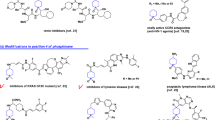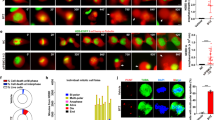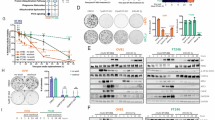Abstract
Polyoma small T antigen (PyST), an early gene product of the polyoma virus, has been shown to cause cell death in a number of mammalian cells in a protein phosphatase 2A (PP2A)-dependent manner. In the current study, using a cell line featuring regulated expression of PyST, we found that PyST arrests cells in mitosis. Live-cell and immunofluorescence studies showed that the majority of the PyST expressing cells were arrested in prometaphase with almost no cells progressing beyond metaphase. These cells exhibited defects in chromosomal congression, sister chromatid cohesion and spindle positioning, thereby resulting in the activation of the spindle assembly checkpoint. Prolonged mitotic arrest then led to cell death via mitotic catastrophe. Cell cycle inhibitors that block cells in G1/S prevented PyST-induced death. PyST-induced cell death that occurs during M is not dependent on p53 status. These data suggested, and our results confirmed, that PP2A inhibition could be used to preferentially kill cancer cells with p53 mutations that proliferate normally in the presence of cell cycle inhibitors.
This is a preview of subscription content, access via your institution
Access options
Subscribe to this journal
Receive 50 print issues and online access
$259.00 per year
only $5.18 per issue
Buy this article
- Purchase on SpringerLink
- Instant access to full article PDF
Prices may be subject to local taxes which are calculated during checkout







Similar content being viewed by others
References
Cheng J, DeCaprio JA, Fluck MM, Schaffhausen BS . Cellular transformation by Simian Virus 40 and Murine Polyoma Virus T antigens. Semin Cancer Biol 2009; 19: 218–228.
Lane DP, Crawford LV . T antigen is bound to a host protein in SV40-transformed cells. Nature 1979; 278: 261–263.
Linzer DI, Levine AJ . Characterization of a 54K dalton cellular SV40 tumor antigen present in SV40-transformed cells and uninfected embryonal carcinoma cells. Cell 1979; 17: 43–52.
Whitman M, Kaplan DR, Schaffhausen B, Cantley L, Roberts TM . Association of phosphatidylinositol kinase activity with polyoma middle-T competent for transformation. Nature 1985; 315: 239–242.
Pallas DC, Shahrik LK, Martin BL, Jaspers S, Miller TB, Brautigan DL et al. Polyoma small and middle T antigens and SV40 small t antigen form stable complexes with protein phosphatase 2A. Cell 1990; 60: 167–176.
Mullane KP, Ratnofsky M, Cullere X, Schaffhausen B. Signaling from polyomavirus middle T and small T defines different roles for protein phosphatase 2A. Mol Cell Biol 1998; 18: 7556–7564.
Janssens V, Rebollo A . The role and therapeutic potential of Ser/Thr phosphatase PP2A in apoptotic signalling networks in human cancer cells. Curr Mol Med 2012; 12: 268–287.
Janssens V, Goris J . Protein phosphatase 2A: a highly regulated family of serine/threonine phosphatases implicated in cell growth and signalling. Biochem J 2001; 353: 417–439.
Janssens V, Goris J, Van Hoof C . PP2A: the expected tumor suppressor. Curr Opin Genet Dev 2005; 15: 34–41.
Lechward K, Awotunde OS, Swiatek W, Muszynska G . Protein phosphatase 2A: variety of forms and diversity of functions. Acta Biochim Pol 2001; 48: 921–933.
Seshacharyulu P, Pandey P, Datta K, Batra SK . Phosphatase: PP2A structural importance, regulation and its aberrant expression in cancer. Cancer Lett 2013; 335: 9–18.
Sents W, Ivanova E, Lambrecht C, Haesen D, Janssens V . The biogenesis of active protein phosphatase 2A holoenzymes: a tightly regulated process creating phosphatase specificity. FEBS J 2013; 280: 644–661.
Schonthal AH . Role of serine/threonine protein phosphatase 2A in cancer. Cancer Lett 2001; 170: 1–13.
Zhou J, Pham HT, Walter G . The formation and activity of PP2A holoenzymes do not depend on the isoform of the catalytic subunit. J Biol Chem 2003; 278: 8617–8622.
Andrabi S, Hwang JH, Choe JK, Roberts TM . Schaffhausen BS. Comparisons between murine polyomavirus and Simian virus 40 show significant differences in small T antigen function. J Virol 2011; 85: 10649–10658.
Andrabi S, Gjoerup OV, Kean JA, Roberts TM . Schaffhausen B. Protein phosphatase 2A regulates life and death decisions via Akt in a context-dependent manner. Proc Natl Acad Sci USA 2007; 104: 19011–19016.
Zhu ZY, Veldman GM, Cowie A, Carr A, Schaffhausen B, Kamen R . Construction and functional characterization of polyomavirus genomes that separately encode the three early proteins. J Virol 1984; 51: 170–180.
Zheng B, Woo CF, Kuo JF . Mitotic arrest and enhanced nuclear protein phosphorylation in human leukemia K562 cells by okadaic acid, a potent protein phosphatase inhibitor and tumor promoter. J Biol Chem 1991; 266: 10031–10034.
Toyoshima F, Nishida E . Spindle orientation in animal cell mitosis: roles of integrin in the control of spindle axis. J Cell Physiol 2007; 213: 407–411.
Sharp-Baker H, Chen RH . Spindle checkpoint protein Bub1 is required for kinetochore localization of Mad1, Mad2, Bub3, and CENP-E, independently of its kinase activity. J Cell Biol 2001; 153: 1239–1250.
Taylor SS, Hussein D, Wang Y, Elderkin S, Morrow CJ . Kinetochore localisation and phosphorylation of the mitotic checkpoint components Bub1 and BubR1 are differentially regulated by spindle events in human cells. J Cell Sci 2001; 114: 4385–4395.
Kwiatkowski N, Jelluma N, Filippakopoulos P, Soundararajan M, Manak MS, Kwon M et al. Small-molecule kinase inhibitors provide insight into Mps1 cell cycle function. Nat Chem Biol 2010; 6: 359–368.
Sakaue-Sawano A, Kurokawa H, Morimura T, Hanyu A, Hama H, Osawa H et al. Visualizing spatiotemporal dynamics of multicellular cell-cycle progression. Cell 2008; 132: 487–498.
Marusyk A, Wheeler LJ, Mathews CK, DeGregori J . p53 mediates senescence-like arrest induced by chronic replicational stress. Mol Cell Biol 2007; 27: 5336–5351.
Blagosklonny MV, Darzynkiewicz Z . Cyclotherapy: protection of normal cells and unshielding of cancer cells. Cell Cycle 2002; 1: 375–382.
Schaffhausen BS, Roberts TM . Lessons from polyoma middle T antigen on signaling and transformation: A DNA tumor virus contribution to the war on cancer. Virology 2009; 384: 304–316.
Daum JR, Potapova TA, Sivakumar S, Daniel JJ, Flynn JN, Rankin S et al. Cohesion fatigue induces chromatid separation in cells delayed at metaphase. Curr Biol 2011; 21: 1018–1024.
Kitajima TS, Sakuno T, Ishiguro K, Iemura S, Natsume T, Kawashima SA et al. Shugoshin collaborates with protein phosphatase 2A to protect cohesin. Nature 2006; 441: 46–52.
Tang Z, Shu H, Qi W, Mahmood NA, Mumby MC, Yu H . PP2A is required for centromeric localization of Sgo1 and proper chromosome segregation. Dev Cell 2006; 10: 575–585.
Riedel CG, Katis VL, Katou Y, Mori S, Itoh T, Helmhart W et al. Protein phosphatase 2A protects centromeric sister chromatid cohesion during meiosis I. Nature 2006; 441: 53–61.
Dai J, Kateneva AV, Higgins JM . Studies of haspin-depleted cells reveal that spindle-pole integrity in mitosis requires chromosome cohesion. J Cell Sci 2009; 122: 4168–4176.
Foley EA, Maldonado M, Kapoor TM . Formation of stable attachments between kinetochores and microtubules depends on the B56-PP2A phosphatase. Nat Cell Biol 2011; 13: 1265–1271.
Zhu M, Settele F, Kotak S, Sanchez-Pulido L, Ehret L, Ponting CP et al. MISP is a novel Plk1 substrate required for proper spindle orientation and mitotic progression. J Cell Biol 2013; 200: 773–787.
Yang CS, Vitto MJ, Busby SA, Garcia BA, Kesler CT, Gioeli D et al. Simian virus 40 small t antigen mediates conformation-dependent transfer of protein phosphatase 2A onto the androgen receptor. Mol Cell Biol 2005; 25: 1298–1308.
Yang SI, Lickteig RL, Estes R, Rundell K, Walter G, Mumby MC . Control of protein phosphatase 2A by simian virus 40 small-t antigen. Mol Cell Biol 1991; 11: 1988–1995.
Scheidtmann KH, Mumby MC, Rundell K, Walter G . Dephosphorylation of simian virus 40 large-T antigen and p53 protein by protein phosphatase 2A: inhibition by small-t antigen. Mol Cell Biol 1991; 11: 1996–2003.
Kawabe T . G2 checkpoint abrogators as anticancer drugs. Mol Cancer Ther 2004; 3: 513–519.
Neviani P, Santhanam R, Oaks JJ, Eiring AM, Notari M, Blaser BW et al. FTY720, a new alternative for treating blast crisis chronic myelogenous leukemia and Philadelphia chromosome-positive acute lymphocytic leukemia. J Clin Invest 2007; 117: 2408–2421.
Hwang JH, Jiang T, Kulkarni S, Faure N . Schaffhausen BS. Protein phosphatase 2A isoforms utilizing Abeta scaffolds regulate differentiation through control of Akt protein. J Biol Chem 2013; 288: 32064–32073.
Honkanen RE, Golden T . Regulators of serine/threonine protein phosphatases at the dawn of a clinical era? Curr Med Chem 2002; 9: 2055–2075.
Swingle M, Ni L, Honkanen RE . Small-molecule inhibitors of ser/thr protein phosphatases: specificity, use and common forms of abuse. Methods Mol Biol 2007; 365: 23–38.
Gaillard S, Fahrbach KM, Parkati R, Rundell K . Overexpression of simian virus 40 small-T antigen blocks centrosome function and mitotic progression in human fibroblasts. J Virol 2001; 75: 9799–9807.
Gjoerup O, Zaveri D, Roberts TM . Induction of p53-independent apoptosis by simian virus 40 small t antigen. J Virol 2001; 75: 9142–9155.
Li S, Brignole C, Marcellus R, Thirlwell S, Binda O, McQuoid MJ et al. The adenovirus E4orf4 protein induces G2/M arrest and cell death by blocking protein phosphatase 2A activity regulated by the B55 subunit. J Virol 2009; 83: 8340–8352.
Li S, Szymborski A, Miron MJ, Marcellus R, Binda O, Lavoie JN et al. The adenovirus E4orf4 protein induces growth arrest and mitotic catastrophe in H1299 human lung carcinoma cells. Oncogene 2009; 28: 390–400.
Moule MG, Collins CH, McCormick F, Fried M . Role for PP2A in ARF signaling to p53. Proc Natl Acad Sci USA 2004; 101: 14063–14066.
O'Shea CC, Fried M . Modulation of the ARF-p53 pathway by the small DNA tumor viruses. Cell Cycle 2005; 4: 449–452.
Blagosklonny MV . Mitotic arrest and cell fate: why and how mitotic inhibition of transcription drives mutually exclusive events. Cell Cycle 2007; 6: 70–74.
Castedo M, Perfettini JL, Roumier T, Andreau K, Medema R, Kroemer G . Cell death by mitotic catastrophe: a molecular definition. Oncogene 2004; 23: 2825–2837.
Kochupurakkal BS, Iglehart JD . Nourseothricin N-acetyl transferase: a positive selection marker for mammalian cells. PLoS ONE 2013; 8: e68509.
Dai J, Sullivan BA, Higgins JM . Regulation of mitotic chromosome cohesion by Haspin and Aurora B. Dev Cell 2006; 11: 741–750.
Chen HH, Zhao S, Song JG . TGF-beta1 suppresses apoptosis via differential regulation of MAP kinases and ceramide production. Cell Death Differ 2003; 10: 516–527.
Acknowledgements
This work was supported by an National Institutes of Health PO1 grant CA50661 to TMR, BSS and DML; and an RO1 grant to TMR (CA30002) and BSS (CA34722); and a Ramalingaswami fellowship and a CREST fellowship to SA. JMGH is supported by the Association for International Cancer Research, and is a Scholar of the Leukemia and Lymphoma Society. We thank Drs Jennifer Spangle and Meera Bhanu for their helpful comments on this manuscript.
Author information
Authors and Affiliations
Corresponding author
Ethics declarations
Competing interests
The authors declare no conflict of interest.
Additional information
Supplementary Information accompanies this paper on the Oncogene website
Supplementary information
Rights and permissions
About this article
Cite this article
Pores Fernando, A., Andrabi, S., Cizmecioglu, O. et al. Polyoma small T antigen triggers cell death via mitotic catastrophe. Oncogene 34, 2483–2492 (2015). https://doi.org/10.1038/onc.2014.192
Received:
Revised:
Accepted:
Published:
Issue date:
DOI: https://doi.org/10.1038/onc.2014.192



